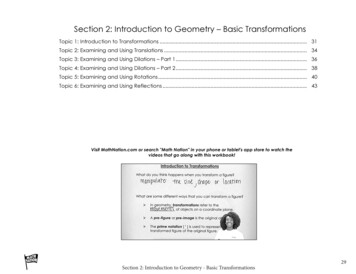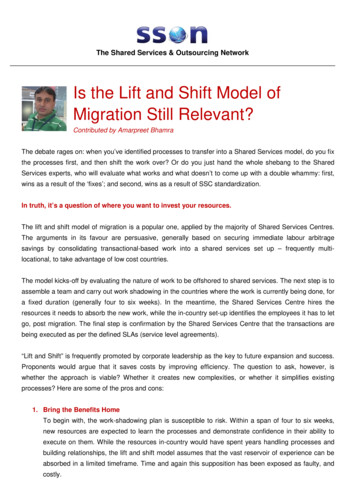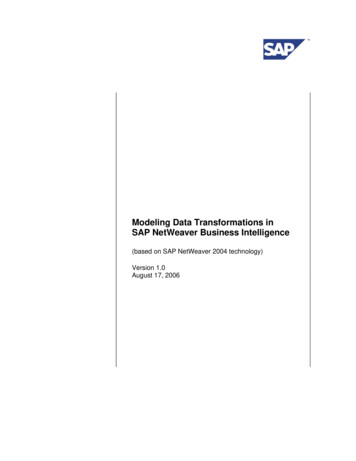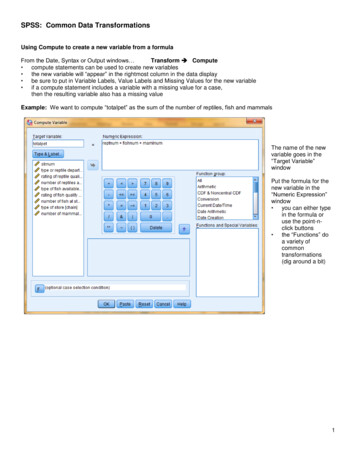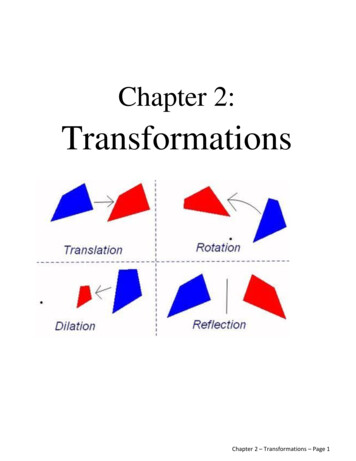
Transcription
Chapter 2:TransformationsChapter 2 – Transformations – Page 1
Unit 2: ping)5)rigid motion (isometry)6)orientation7)line reflection8)line of er of rotation13)angle of rotation14)point reflectionChapter 2 – Transformations – Page 2
15)dilation16)center of dilation17)scale factor18)enlargement19)reductionChapter 2 – Transformations – Page 3
Day 1: Line ReflectionsG.CO.2 Represent transformations in the plane, e.g., using transparencies and geometry software; describe transformations asfunctions that take points in the plane as inputs and give other points as outputs. Compare transformations that preserve distanceand angle to those that do not (e.g. translation vs. horizontal stretch.)G.CO.4. Develop definitions of reflections, translations, and rotations in terms of angles, circles, perpendicular lines, parallel lines,and line segments.G.CO.5. Given a geometric figure and a rotation, reflection, or translation, draw the transformed figure, e.g. using graph paper,tracing paper, or geometry software. Specify a sequence of transformations that will carry one figure onto another.Warm-UpIf 𝑓(𝑥) 3𝑥 4, find 𝑓(1).A transformation is a change in the position, size, or shape of a figure. A transformation takes points in theplane and maps them to other points in the plane.The original figure (the inputs for the transformation) is called the preimage.The resulting figure (the outputs) is called the image.We can represent transformations in a number of ways.1) Mapping NotationA transformation is sometimes called a mapping. Thetransformation maps the preimage to the image. In mappingnotation, arrow notation ( ) is used to describe atransformation, and primes (′) are used to label the image.2) Function NotationThe notation 𝑻(𝑨) 𝑨′ means that a transformation 𝑇 maps a point 𝐴 onto its image, 𝐴′.3) Coordinate NotationCoordinate notation will tell you how to change the coordinates of a general point (𝑥, 𝑦) to get the coordinatesof its image. For example, (𝑥, 𝑦) (𝑥 5, 𝑦 3) means you get the image point by adding 5 to each x andsubtracting 3 from each y.Chapter 2 – Transformations – Page 4
Exercise1) Given the transformation: 𝑇(𝐵) 𝐶Which point is the pre-image? Which point is the image?2) Given a transformation F: (𝑥, 𝑦) (𝑥 1, 𝑦 1)a) Describe what this transformation is going to do to a point in the plane.b) Transformations are functions because each input in the domain is mapped to a unique output in the range.How would you describe the domain of F?The range of F?Rigid MotionsA rigid motion is the action of taking an object and moving it to a different location without altering its shapeor size. Reflections, rotations, translations, and glide reflections are all examples of rigid motions. In fact, everyrigid motion is one of these four kinds.Rigid motions are also called isometries. Rigid motions are therefore called isometric transformations.Examples of rigid motions:NOT rigid motions:The orientation of a figure is the arrangement of points around a figure. Orientation can be clockwise orcounterclockwise. There are two types of rigid motions.Chapter 2 – Transformations – Page 5
A proper rigid motion preserves orientation.(It keeps it the same.)Both the figure and its image have clockwiseorientations. This rigid motion preservesorientation.Exercise1)3)An improper rigid motion changes orientation. 𝐴𝐵𝐶 has a clockwise orientation but 𝐴′𝐵′𝐶′ hasa counterclockwise orientation. Orientationchanges, and this is an improper rigid motion.Are the following transformations rigid motions? If so, do they preserve or changeorientation?2)4)Chapter 2 – Transformations – Page 6
For #5-6, a transformation is mapped below in coordinate notation. Graph the image on the same set of axes.Then state whether the transformation is a rigid motion.5)6)Line ReflectionsSo, a line reflection is a “flip” across a line. This line is called the line of reflection.The line of reflection is the perpendicular bisector of the segment connecting each point and its image.If a point is on the line of reflection, its image is the original point.Chapter 2 – Transformations – Page 7
Other properties of line reflections: Reflections are improper rigid motions. They preserve distance, but change orientation. Applying the same reflection twice gives the identity motion. That is, the figure goes back to its originalposition. Angle measure, midpoint, and collinearity are also preserved.Examples of line reflections:Model ProblemExerciseUse a ruler or tracing paper to sketch the reflection of each figure in the line provided.Use a ruler or tracing paper to sketch the reflection of each figure in the line provided.Chapter 2 – Transformations – Page 8
Identifying Line ReflectionsModel ProblemExerciseIs the transformation shown a line reflection? Justify your answer.Is the transformation shown a line reflection? Justify your answer.Chapter 2 – Transformations – Page 9
SummaryA transformation is a change in the position, size, or shape of a figure.A rigid motion is the action of taking an object and moving it to a different location without altering its shapeor size. Reflections, rotations, translations, and glide reflections are all examples of rigid motions. Rigidmotions preserve distance, angle measure, collinearity, parallelism, and midpoint.A line reflection is a transformation where the line of reflection is the perpendicular bisector of each segmentcontaining a point and its image. It is described as a “flip” over a line.Homework5)Chapter 2 – Transformations – Page 10
6) Consider the line reflection at right, where 𝑟𝑘 (𝐴𝐵𝐶𝐷) 𝐴′𝐵′𝐶′𝐷′.Answer TRUE or FALSE.a) 𝐴 𝐴′̅̅̅̅̅̅̅̅̅̅ 𝐵′𝐶′b) 𝐵𝐶̅̅̅̅ ̅̅̅̅̅̅c) 𝐵𝐶𝐴′𝐷′̅̅̅̅ 𝐶𝐷̅̅̅̅, then ̅̅̅̅̅̅d) 𝐼𝑓 𝐴𝐵𝐴′𝐵′ ̅̅̅̅̅̅̅𝐶 ′ 𝐷′ .𝑘̅̅̅̅ , then ̅̅̅̅̅̅e) 𝐼𝑓 ̅̅̅̅𝐴𝐵 𝐵𝐶𝐴′𝐵′ ̅̅̅̅̅̅̅𝐵 ′ 𝐶 ′ .f) Quadrilateral 𝐴𝐵𝐶𝐷 and quadrilateral 𝐴′𝐵′𝐶′𝐷′ have the sameorientation.g) Explain why the transformation that maps 𝐴𝐵𝐶𝐷 onto 𝐴′𝐵′𝐶′𝐷′ is aline reflection. You may want to use words like perpendicularbisector, image, and segment, among others.7)Chapter 2 – Transformations – Page 11
Day 2: More on Line Reflections: Graphing and ConstructionsG.CO.2 Represent transformations in the plane, e.g., using transparencies and geometry software; describe transformations asfunctions that take points in the plane as inputs and give other points as outputs. Compare transformations that preserve distance andangle to those that do not (e.g. translation vs. horizontal stretch.)G.CO.4. Develop definitions of reflections, translations, and rotations in terms of angles, circles, perpendicular lines, parallel lines,and line segments.G.CO.5. Given a geometric figure and a rotation, reflection, or translation, draw the transformed figure, e.g. using graph paper, tracingpaper, or geometry software. Specify a sequence of transformations that will carry one figure onto another.Warm-UpIs this a line reflection? Justify your answer using appropriate mathematical vocabulary.Special Line ReflectionsSome line reflections have special rules. We can develop these rules by performing them on points in thecoordinate plane and examining the coordinates of their image.1) Reflection in the x-axis (𝑟𝑥 𝑎𝑥𝑖𝑠 )M(-1, 5) 𝑀′ ()D (1, 5) 𝐷′ ()A (4, 3) 𝐴′ ()W (-1, 4) 𝑊 ′ ()Rule for Reflection in the x-axis(𝑥, 𝑦) (,)To reflect in the x-axis,Chapter 2 – Transformations – Page 12
2) Reflection in the y-axis (𝑟𝑦 𝑎𝑥𝑖𝑠 )W(-2, 3) 𝑊 ′ ()S (-2, 1) 𝑆 ′ ()I (-5, -1) 𝐼 ′ ()P (-4, -2) 𝑃′ ()Rule for Reflection in the y-axis(𝑥, 𝑦) (,)To reflect in the y-axis,3) Reflection in the line y x (𝑟𝑦 𝑥 )J(4, -3) 𝐽′ ()A (3, -1) 𝐴′ ()T (5, -2) 𝑇 ′ ()S (4, 2) 𝑆 ′ ()Rule for Reflection in the line y xIs ry x an isometry?(𝑥, 𝑦) (,)To reflect in the line y x ,Chapter 2 – Transformations – Page 13
PracticeChapter 2 – Transformations – Page 14
Reflections across Vertical and Horizontal LinesOther lines can be used as lines of reflection as well.Reminder! Equations of Horizontal and Vertical Linesx a numbery a numberModel ProblemsSketch the reflection of the figure in the line indicated.What are the coordinates of the image?1) Reflection in x -12) Reflection in y 1Chapter 2 – Transformations – Page 15
3) In the diagram at right, 𝐴𝐵𝐶 is mapped onto 𝑋𝑌𝑍 by thetransformation (𝑥, 𝑦) ( 𝑥 6, 𝑦). Notice that thistransformation is equivalent to a reflection in the line 𝑥 3.Prove that the line 𝑥 3 is the perpendicular bisector of thesegment with endpoints (𝑥, 𝑦) 𝑎𝑛𝑑 ( 𝑥 6, 𝑦). (Hint: Use themidpoint formula.)4) Sketch the line of reflection on the diagram below. Then write arule for the reflection. Be sure to include the name of thetransformation and the equation of the line of reflection.Rule:ExerciseSketch the reflection of each figure in the line indicated.1) Reflection across x 12)Chapter 2 – Transformations – Page 16
3) A transformation 𝑇 is given by the rule (𝑥, 𝑦) ( 𝑥 4, 𝑦).a) Graph and state the coordinates of the image of the figure below under transformation 𝑇.b) Show that transformation 𝑇 is a line reflection.c) State the equation of the line of reflection.4) Write a rule for each reflection.SummaryRules for ReflectionsChapter 2 – Transformations – Page 17
Constructing a Line ReflectionTask: Construct the image of the line segment after a reflection in the given line.You Try:Justify this construction (Fill in the blanks):1. We construct a line to the given line passing through the givenpoint and its image.2. Then we construct a segment where the line of reflection goes through that segment’s .3. Therefore, the given line is the of thesegment containing each given point and its image, making it a line of reflection.Chapter 2 – Transformations – Page 18
Summary To reflect a figure across a horizontal or vertical line, sketch the line of reflection, and sketch the imageof each point individually. To describe a rule for a line reflection, observe the line of symmetry between the original figure and theimage.HomeworkChapter 2 – Transformations – Page 19
Sketch the image of the figure shown in the line indicated.Write the rule for the transformation shown.Chapter 2 – Transformations – Page 20
Day 3: TranslationsG.CO.2 Represent transformations in the plane, e.g., using transparencies and geometry software; describe transformations asfunctions that take points in the plane as inputs and give other points as outputs. Compare transformations that preserve distance andangle to those that do not (e.g. translation vs. horizontal stretch.)G.CO.4. Develop definitions of reflections, translations, and rotations in terms of angles, circles, perpendicular lines, parallel lines,and line segmentsG.CO.5. Given a geometric figure and a rotation, reflection, or translation, draw the transformed figure, e.g. using graph paper, tracingpaper, or geometry software. Specify a sequence of transformations that will carry one figure onto another.Warm-upChapter 2 – Transformations – Page 21
TranslationsDefinition: A translation (notation 𝑇𝑎,𝑏 ) is a transformation of the plane that slides every pointof a figure the same distance in the same direction.So a translation “slides” an object a fixed distance in a given direction.In the example below, notice how each vertex moves the same distance in the same direction.Check all properties that are preserved under a translation:distanceorientationangle rityChapter 2 – Transformations – Page 22
Notations:𝑇 7, 3 : The -7 tells you to subtract 7 from the x-coordinates and the -3 tells you to subtract 3 from the ycoordinates: This is read as “the x and y coordinates will be translated into x-7 and y-3”. xcoordinates moves 7 units to the left, y-coordinates moves 3 units down : This is a vector. A vector is a directed line segment and may also be used to show themovement of a translation. This vector would translate a pre-image 4 units to the right (positive direction) and 9units down (negative direction).Rules:x a : the x-coordinates moves in the positive(right) directiony b : the y-coordinates moves in the positive (up)x-a : the x-coordinates moves in the negativey-b : the y-coordinates moves in the negative(left) direction(down) directionModel Problemdirection𝑇5,1B:(, ) B’: ( 5, 1)B’ :G : ( , ) G’: ( 5, 1)G’ :T:(, ) T’: ( 5, 1)T’ :Which way did the pre-image move?andChapter 2 – Transformations – Page 23
Exercise(x,y)(x-1, y-4) 〈 2,5〉Model Problem Write the rule for the translation shown belowRule:Chapter 2 – Transformations – Page 24
Exercise: Write the rule for the translation in two ways (𝑇𝑎,𝑏 , (x,y), or)Rule:Rule:Given a point under translation T, find the coordinates of another point under the sametranslation.Model ProblemsPracticeChapter 2 – Transformations – Page 25
Write two translations as a single translation.Rule:S: (x,y)(x a, y b)T: (x,y)(x c, y d)(x,y)(x (a c), y (b d))Note: watch signs!Model ProblemChapter 2 – Transformations – Page 26
Exercise:1) A group of hikers walks 2 miles east and then1 mile north. After taking a break, they thenhike 4 miles east and another mile north toset up camp. What vector describes their hikefrom their starting position to camp? Let 1unit represent 1 mile.Use the graph to the right. If the hikersstarted at P (-4, 2), what will be there finalposition?2) In a video game, acharacter at P (8, 3) movesthree times, as described bythe translations shown atthe right. What is the finalposition of the characterafter three moves?Move 1:Move 2:Move 3:𝑇2,7𝑇 10, 4𝑇1, 5Chapter 2 – Transformations – Page 27
Model ProblemGraph ΔABC with A (2,-3), B (2,-6), C (5,-3)Use ΔABC to answer the question below.Chapter 2 – Transformations – Page 28
SummaryThree notations for translations: 𝑇𝑎,𝑏 , (x, y) (x a, y b), 〈𝑎, 𝑏〉x a : the x-coordinates moves in the positive(right) directiony b : the y-coordinates moves in the positive (up)x-a : the x-coordinates moves in the negativey-b : the y-coordinates moves in the negative(left) direction(down) directiondirectionChapter 2 – Transformations – Page 29
HomeworkWrite a rule for each transformation described.1)2)3)4)Two units left and 5 units upEight units right and 4 units down7 units down2 units rightChapter 2 – Transformations – Page 30
Write the rule for the translations pictured in the graphs below:Chapter 2 – Transformations – Page 31
Day 4: RotationsG.CO.2 Represent transformations in the plane, e.g., using transparencies and geometry software; describe transformations asfunctions that take points in the plane as inputs and give other points as outputs. Compare transformations that preserve distance andangle to those that do not (e.g. translation vs. horizontal stretch.)G.CO.3 Given a rectangle, parallelogram, trapezoid, or regular polygon, describe the rotations and reflections that carry it onto itself.G.CO.4. Develop definitions of reflections, translations, and rotations in terms of angles, circles, perpendicular lines, parallel lines,and line segmentsG.CO.5. Given a geometric figure and a rotation, reflection, or translation, draw the transformed figure, e.g. using graph paper, tracingpaper, or geometry software. Specify a sequence of transformations that will carry one figure onto another.Warm-UpUnder a translation, the image of point (-3, 7) is (2, 5). Find the image of point (-4, 2) under the sametranslation.What is a rotation?A rotation is a transformation in which a figure is turned about a fixed point, called the center of rotation.Notice that each point and its image are the same distance from the center of rotation.The angle that a point and its image make with the center of rotation is called the angle of rotation, as shownbelow.Chapter 2 – Transformations – Page 32
Because a full rotation is 360 , angles of rotation are commonly measured in multiples of 90 .IIIIIIIVNotice that the angles are increasing in a counterclockwise direction. This is because positive rotations arecounterclockwise, while negative rotations are clockwise.Visualizing RotationsA figure is graphed below on a set of coordinate axes. Sketch how the figure would look after:a) one rotation of 90 b) two rotations of 90 c) three rotations of 90 Name the quadrant in which each image is located.IIIIIIIVChapter 2 – Transformations – Page 33
Coordinate RuleThe rule for a counter-clockwise rotation of 90 around the origin is given by:(𝑥, 𝑦) ( 𝑦, 𝑥)Model Problem 𝐴𝐵𝐶 has coordinates A(3,1), B(6, 1) and C(6, 3). Sketch and label 𝐴𝐵𝐶 and its image after a rotation of 90 .State the coordinates of the image of 𝐴𝐵𝐶.In which quadrant did the preimage lie? The image?Is a rotation a rigid motion?Check all properties that are preserved under a rotation:distanceorientationangle rityChapter 2 – Transformations – Page 34
ExerciseGraph trapezoid FGHI with vertices F(1,2), G(5,0), H(3,3), and I(4,2).Rotate trapezoid FGHI 90 .Rotations of 180 , 270 , and 360 can be performed by doing the rotation of 90 multiple times.R90 𝑅90 𝑨(𝟐, 𝟏) 𝑅90 𝑩(𝟔, 𝟏) 𝑅90 𝑪(𝟔, 𝟒) R180 𝑅90 𝐴′ () 𝐵′ () 𝐶 ′(𝑅90 𝑅90 ) R270 𝑅90 𝐴′′ () 𝐵′′ () 𝐶 ′′ (𝑅90 𝑅90 ) 𝐴′′′ ()𝐵′′′ ()𝐶′′′()R90 (x, y) ()R180 (x, y) ()R270 (x, y) ()Exercise 𝐴𝐵𝐶 has coordinates A(2,1), B(6, 1) and C(6, 4). Sketch and state the coordinates of 𝐴𝐵𝐶 and its imageafter rotations of 90 , 180 , and 270 . Then write a rule for these rotations.Chapter 2 – Transformations – Page 35
Reminder!R90 (x, y) (-y, x)R180 (x, y) (-x, -y)R270 (x, y) (y, -x)Practice1) What is the image of each point under a counterclockwise rotation of 90 ?a) (7, 1)b) (4, -3)c) (-5, 0)2) What is the image of each point under a counterclockwise rotation of 180 ?a) (-9, 6)b) (4, -12)c) (0, 8)3) What is the image of each point under a counterclockwise rotation of 270 ?a) (0, 5)b) (-10, 7)c) (5, -1)Write the Rule for RotationsRule:Rule:Chapter 2 – Transformations – Page 36
Point Reflection and Reflection in the OriginA point reflection exists when a fixed point, called a point of reflection, is the midpoint of a given point and its̅̅̅̅̅, ̅̅̅̅̅̅̅̅̅̅̅.image. In the diagram at right, P is the midpoint of 𝐶𝐶′𝐵𝐵 ′ , 𝑎𝑛𝑑 𝐴𝐴′Notice that reflection in a point has the same effect as turning a figure upside down.In other words, this transformation has the same result as a rotation of 180 .Therefore, it makes sense that the rule for reflection in the origin (rorigin) should have the same rule as a rotationof 180 , in other words:rorigin (x, y) (-x, -y)The rule for a reflection in the origin is the same as the rule for a rotation of 180 .ExerciseFind the image of each point under rorigin:a) (-4, 3)b) (2, 6)c) (0, -8)Chapter 2 – Transformations – Page 37
SummaryRules to Memorize:Chapter 2 – Transformations – Page 38
Homework1) When a point (a, b) is rotated counterclockwise about the origin, (a, b) (b, a) is the result of arotation of .2) Graph trapezoid FGHI with verticesF(1,2), G(5,0), H(3,3), and I(4,2).Rotate trapezoid FGHI 180 .3) Write a rule for the rotations below.Chapter 2 – Transformations – Page 39
4) Write the coordinates of the given point after a reflection in the origin:a) (-9, -8)b) (4, 14)c) (4, 6)5)6)Chapter 2 – Transformations – Page 40
7)8)9)Chapter 2 – Transformations – Page 41
Day 5: DilationsG-SRT.1 Verify experimentally the properties of dilations given by a center and a scale factor: a. A dilation takes a line not passingthrough the center of the dilation to a parallel line, and leaves a line passing through the center unchanged. b. The dilation of a linesegment is longer or shorter in the ratio given by the scale factor.Warm-UpFind the image of (-5, 3) after each transformation.rx-axisry-axisry xT-3, 2R90R180R270(-5, 3)When the scale factor k 0, the dilation will also contain a rotation of 180 .A dilation of scale factor k is performed using the rule:Dk (x, y) (kx, ky)Important Facts A dilation is NOT a rigid motion. Its image is not congruent to the original figure.Since the ratio of the lengths of segments in the figure and its image is a constant, the figure and itsimage are always similar.This is a dilation. The figures are similar:This is NOT a dilation. The figures are NOT similar:Chapter 2 – Transformations – Page 42
Exploration̅̅̅̅𝐴𝐵 has coordinates 𝐴(3, 1) and 𝐵( 1, 4).1) Graph and label ̅̅̅̅𝐴𝐵 .2) Determine and state the coordinates of theimage of ̅̅̅̅𝐴𝐵 under 𝐷2 with respect to theorigin.𝐴(3, 1) 𝐴′ ()) 𝐵′ ()𝐵(3) Justify informally that the transformationyou performed is a dilation.Verifying the Properties of a DilationUse the distance formula to find:𝐴𝐵𝐴′𝐵′What do you notice?Chapter 2 – Transformations – Page 43
Parallel lines have the same slope. Use the slope formula to find the slope of ̅̅̅̅𝐴𝐵 and ̅̅̅̅̅̅𝐴′𝐵′.𝑠𝑙𝑜𝑝𝑒 𝑜𝑓 ̅̅̅̅𝐴𝐵𝑠𝑙𝑜𝑝𝑒 𝑜𝑓 ̅̅̅̅̅̅𝐴′𝐵′What conclusion can you draw about these line segments?Model ProblemsGraph and state the coordinates of the image of each dilation, using the given scale factor. Each dilation is withrespect to the origin.1)ExerciseGraph and state the coordinates of the image of each dilation, using the given scale factor. Eachdilation is with respect to the origin.2)Scale factor: -3Chapter 2 – Transformations – Page 44
Model ProblemsFind the scale factor in each dilation given.a) (-6, 4) (-9, 6)b)ExerciseFind the scale factor in each dilation.1) (4,8) (-2, -4)4) This dilation where C is the center of dilation:2) (4, 5) (12, 15)3) (-5, 4) (10, -8)Chapter 2 – Transformations – Page 45
Homework1) What is the image of the point (9, 1) under the dilation 𝐷2 ?2) Find the image of the point (-3, 2) under the dilation (3x, 3y).3) A dilation maps point A (2, 6) onto A’ (1, 3). What is the scale factor?4) A triangle has sides of length 12, 14, and 16. Find the perimeter of this triangle after a dilation 𝐷2 .5) Point B’ (14, 21) is the image of point B(2, 3) under a certain dilation. Find the image of point (-1, 0)under the same dilation.ReviewWrite the image of each point under the transformation indicated.rx-axisry-axisry xrx 3R90 R180 T3, 0D2(3, 4)(-2, 6)(4, 0)Chapter 2 – Transformations – Page 46
Day 6: More on DilationsG-SRT.1 Verify experimentally the properties of dilations given by a center and a scale factor: a. A dilation takes a line not passingthrough the center of the dilation to a parallel line, and leaves a line passing through the center unchanged. b. The dilation of a linesegment is longer or shorter in the ratio given by the scale factor.Warm-UpIs this transformation a dilation? Justify your answer mathematically.Sketching a Dilation Center is Outside the FigureThe center of dilation and the scale factor of a dilation is given. Using acompass and a ruler, construct the image of the figure after the dilation.′ 𝐵′.̅̅̅̅̅̅Label it 𝐴Questions for Thought:What is the ratio of 𝐴′ 𝐵 ′ to 𝐴𝐵? of 𝑆𝐵 ′ to 𝑆𝐵? of 𝑆𝐴′ to 𝑆𝐴?Is parallelism preserved under this transformation?Chapter 2 – Transformations – Page 47
Center is On the FigureQuestions for Thought1) How is this dilation different from the previous one?2) Do any points remain invariant (the same) under this dilation? Why do you think that is?̅̅̅̅ 𝑆𝐶̅̅̅̅̅′ ? If parallelism is preserved under a dilation, how do you explain this result?3) Is 𝑆𝐶Chapter 2 – Transformations – Page 48
Dilating a Line1)2) What is the equation of the new line?3) Plot the point (3, 0) on the same set of axes. Using (3, 0) as the center of dilation, let’s attempt to do thesame dilation of 2.a) What is the image of (3, 0) under this dilation? Why?b) What is the image of (0, 2) under this dilation?What mathematical term describes the relationship between (0, 2) and its image?c) What is the equation of the new line this time?d) Complete this sentence: When a dilation is performed on a line with respect to a point on that sameline, the equation is .Chapter 2 – Transformations – Page 49
HomeworkDilations and Review5)Chapter 2 – Transformations – Page 50
11) Dilation with Center Inside the Figure. Sketch the dilation of the figure below if the center of dilation is atS and the scale factor is 2.12) Margot superimposed the image of the dilation of a figure on its original figure as shown. Identify thecenter of this dilation. Explain how you found it.Chapter 2 – Transformations – Page 51
13) Find the value of x and the scale factor of the dilation below.14)Chapter 2 – Transformations – Page 52
Day 7: Composition of TransformationsG.CO.5. Given a geometric figure and a rotation, reflection, or translation, draw the transformed figure, e.g. using graph paper, tracingpaper, or geometry software. Specify a sequence of transformations that will carry one figure onto another.Warm-UpWhat is a composition?When two or more transformations are combined to form a new transformation, the result is called acomposition of transformations.In a composition:1) The first transformation is performed.2) The second transformation is performed on the image of the first.The symbol for a composition of transformations is an open circle. ( )Example:Read: “reflection in the x-axis ON a translation of (3, 4)” Important Note: Compositions are always done in reverse!!Chapter 2 – Transformations – Page 53
Model Problem A 𝐴𝐵𝐶 has coordinates 𝐴( 6,0), 𝐵( 3, 5), 𝑎𝑛𝑑 𝐶(0, 2). Find the coordinates of image of 𝐴′′𝐵′′𝐶′′ underthe composition 𝒓𝒙 𝒂𝒙𝒊𝒔 𝑻𝟐,𝟑 . Sketch 𝐴𝐵𝐶 and 𝐴′′𝐵′′𝐶′′ on the axes below.a) Which transformation goes first?𝑇2,3A(-6,0) 𝐴′(𝑇2,3B(-3,5) 𝐵′() 𝑟𝑥 𝑎𝑥𝑖𝑠) ,𝑇2,3C(0, 2) 𝐶′(b)(1)(2)(3)(4)𝑟𝑥 𝑎𝑥𝑖𝑠,,𝑟𝑥 𝑎𝑥𝑖𝑠) 𝐴′′(,)𝐵′′(,)𝐶′′(,)Which statement is not true? 𝐴 𝐴′′̅̅̅̅ ̅̅̅̅̅̅̅̅𝐵𝐶𝐵 ′′ 𝐶 ′′̅̅̅̅ ̅̅̅̅̅̅̅̅𝐵𝐶𝐵 ′′ 𝐶 ′′̅̅̅̅ ̅̅̅̅̅̅̅𝐴𝐶𝐴′′ 𝐶 ′′Exercise1) What is the image of point A(4, 3) under the composition 𝐷2 𝑟𝑦 𝑥 ?𝑟𝑦 𝑥(4,3) (,𝐷2) (,)Remember to work from rightto left!2) What is the image of (3,-1) under the composition 𝑇2,5 𝑟𝑦 𝑎𝑥𝑖𝑠 ?3) Find the image of (-1, 8) under the composition:a) 𝑅90 𝑟𝑦 𝑎𝑥𝑖𝑠b) 𝑟𝑦 𝑎𝑥𝑖𝑠 𝑅90 c) Is the composition of transformations commutative?(i.e. Does changing the order of the composition keep the same image?Chapter 2 – Transformations – Page 54
4)̅̅̅̅ ̅̅̅̅̅̅̅̅5) In Question #4, is 𝐵𝐶𝐵 ′′ 𝐶 ′′ ? Explain why or why not.The Glide ReflectionDefinition:A glide reflection is a transformation in the plane that is the composition of a line reflectionand a translation through a line (a vector) parallel to that line of reflection.Example:is the image ofunder a glide reflection that is a composition of a reflection over theline l and a translation through the vector v.Chapter 2 – Transformations – Page 55
Recognizing Glide Reflections ExampleLook for a line reflection and a translation.The translation should go in the same direction as the line of reflection runs. 𝐴𝐵𝐶 has coordinates A(0, 2), B(4, 2), and C(4, 5).Sketch 𝑨𝑩𝑪 𝐚𝐧𝐝 𝐢𝐭𝐬 𝐢𝐦𝐚𝐠𝐞 𝐮𝐧𝐝𝐞𝐫 𝐫𝐱 𝟐 𝑻𝟎,𝟑Exercise 𝐴𝐵𝐶 has coordinates A(0, 2), B(4, 2), and C(4, 5).Sketch 𝑨𝑩𝑪 and its image under 𝑻 𝟐,𝟎 𝒓𝒙 𝒂𝒙𝒊𝒔Chapter 2 – Transformations – Page 56
Notes on Glide Reflections:1) A glide reflection is an improper rigid motion.(A translation is a proper rigid motion and a reflection is an improper rigid motion. Their composition isan improper rigid motion.)2) Properties preserved under a glide reflection:-DistanceAngle measureParallelism and perpendicularityCollinearityMidpointDescribing a CompositionModel ProblemDescribe a series of transformations that will map OBCD onto OHTE. Are the figures congruent or similar?How do you know?Chapter 2 – Transformations – Page 57
ExerciseDescribing Compositions as a Single TransformationIt is possible that a composition of two transformations may be renamed using one single transformation.For example, the composition of a line reflection in the y-axis followed by a line reflection in the x-axis couldbe described as a single transformation of a reflection in the origin.We can prove this using coordinate geometry using (x, y):𝑟𝑦 𝑎𝑥𝑖𝑠(x, y) (,𝑟𝑥 𝑎𝑥𝑖𝑠) (,)Chapter 2 – Transformations – Page 58
ExerciseTransform the point (x, y) using each composition. Then demonstrate the compositiongraphically using the sample coordinates. Answer all questions that follow.̅̅̅̅ where A(6, 2) andDemonstrate graphically using 𝐴𝐵B(2,4)1) 𝒓𝒚 𝒂𝒙𝒊𝒔 𝒓𝒚 𝒙𝑟𝑦 𝑥(x, y) (𝑟𝑦 𝑎𝑥𝑖𝑠) ,(,)This composition is equivalent to:(1) A reflection in the origin(2) A rotation of 90 (3) A vertical translation(4) A reflection in the x-axisAre the figure and its image congruent or similar?How do you know?Demonstrate graphically using ̅̅̅̅𝐴𝐵 where A(6, 2) andB(2,4)𝟐) 𝑹𝒚 𝒂𝒙𝒊𝒔 𝑹𝟗𝟎 𝑅90 (x, y) (𝑟𝑦 𝑎𝑥𝑖𝑠) ,(,)This composition is equivalent to:(1) A reflection in the line 𝑦 𝑥(2) A rotation of 270 (3) A translation of 2, 3 (4) A reflection in the x-axisDoes this transformation preserve distance? Explain.𝟑) 𝑻𝟒, 𝟏 𝑻𝟔,𝟖𝑇6,8(x, y) (4) 𝑹𝟗𝟎 𝑹𝟏𝟖𝟎 𝑇4, 1) ,(,Write a single translation rule for this composition:(x, y) (,)𝑅180 (x, y) (,𝑅90 ) (,)This composition is equivalent to a rotation of:)Chapter 2 – Transformations – Page 59
Homework1) What is the image of point A(7, 8) under the composition 𝑇2, 1 𝑟𝑦 𝑎𝑥𝑖𝑠 ?𝑟𝑦 𝑎𝑥𝑖𝑠(7,8) (,𝑇2, 1) (,)2) What is the image of (0,4) under the composition 𝑇 1, 3 𝑟𝑥 𝑎𝑥𝑖𝑠 ?3) Find the image of (-1, 2) under the composition:a) 𝑅90 𝑟𝑦 𝑥b) 𝑟𝑜 𝑅180 4) Find the image of (-2, 1) under the composition 𝑟𝑦 𝑎𝑥𝑖𝑠 𝑅180 𝑟𝑜 𝐷25)6)Chapter 2 – Transformations – Page 60
7) Is the following composition a direct or an opposite isometry? Explain your reasoning.𝒓𝒙 𝟐 𝒓𝒙 𝟒 𝒓𝒙 𝟔 𝒓𝒙 𝟖8) 𝐴𝐵𝐶 has coordinates 𝐴(3, 1), 𝐵(6, 1), and 𝐶(6, 6)
G.CO.5. Given a geometric figure and a rotation, reflection, or translation, draw the transformed figure, e.g. using graph paper, tracing paper, or geometry software. Specify a sequence of transformations that will carry one fig

